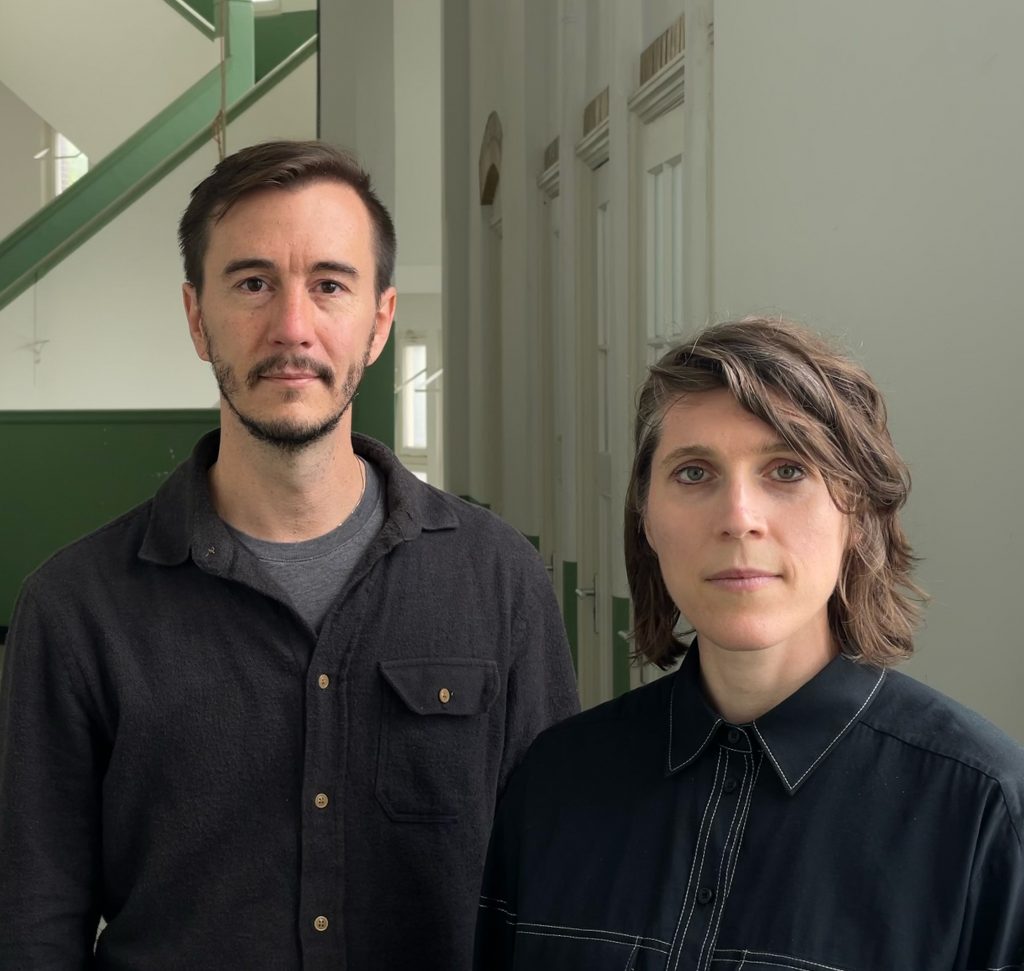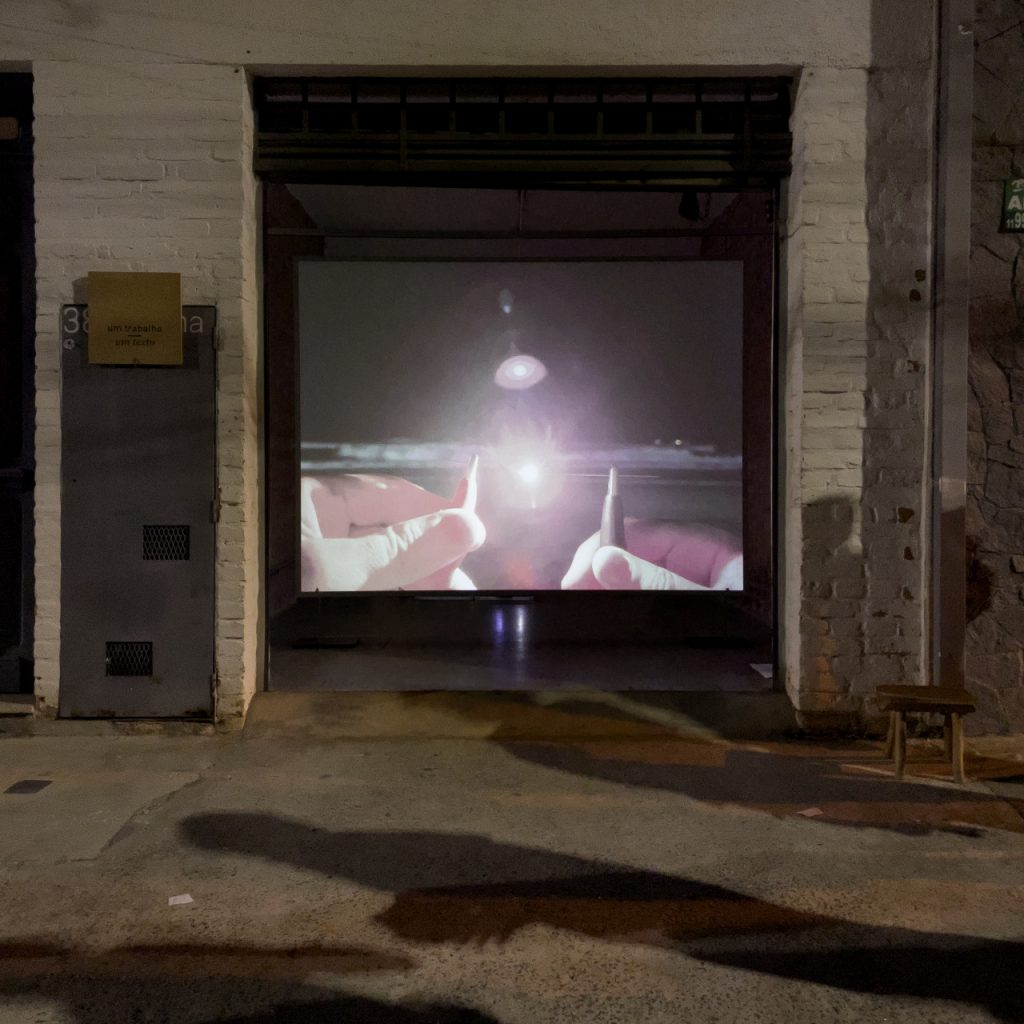Marissa Lee Benedict & David Rueter

Marissa Lee Benedict and David Rueter’s (USA/Netherlands) collaborative site-adapted videos, sculptures, and drawings intercept objects and document processes that extend beyond one’s peripheral vision. Often working with architectural or infrastructural elements hidden in plain sight, the duo lodges materiality, voice, intimacy, and at times their own bodies, into the heart of abstract and technologically-produced spaces.
While at Rupert, Benedict and Rueter will develop and workshop a script for a video that re-imagines Charles and Ray Eames’ short film “Powers of Ten” (1977) as a series of conversations between animators over an editing table. The duo’s film will touch on latent conditions of image, text, and the infinitely expanding desires of archives; the displaced figure of the surveyor as found in Franz Kafka’s 1926 novel “The Castle”; and visual and linguistic forms central to the production of empire. The work will focus on acts of description as fundamental to questions of being, and figuring, in the past, present, and future.
Collaboration and technologically-produced spaces. An interview with Marissa Lee Benedict and David Reuter.
by Augustė Verikaitė (Rupert)
Can you briefly describe your art practice and general concerns or themes that your work explores?
Marissa Lee Benedict: We produce site-adapted videos, sculptures, and drawings that intercept and re-stage encounters with technical processes, infrastructural forms, and things that, by their nature, are difficult to hold. Through our work we encounter massive things—things that extend far beyond our peripheral vision or comprehension—with simple gestures and operations that draw them into relation with particular moments in time, and our own fallible subjectivities.
David Rueter: In recent years, we’ve focused our gaze on the objects, processes, and myths that participate in property, possession, infrastructure, and archive—generally, the spaces where the categories of “private” and “public” are deployed against one another, often under the aegis of technology.
In the particular ways a drawing can be made as a play between the hand and other forces, the ways a moving image can transpose myth, and the ways a material can be pressed to indicate history and context, we find opportunities for encounters in the flesh. The roles and limits inscribed by technology and the state start to feel more mundane, more peculiar, more ambivalent, and more susceptible to other ways of perceiving and knowing.
Being in a collaborative partnership – how has co-authorship shaped you as individuals and what differences do you bring to your artistic practices?
DR: I tend to start from a space that is both philosophical and experimental, where the art emerges from a desire to materialize, or perhaps summon or enact, an impasse of thought. Marissa is a wonderfully curious thinker who tends to begin with the concrete aspects of experience, from materials to affect, through her extensive knowledge, skill, and attention to art-historical registers of perception. After almost ten years together I still learn new things from her every day.
MLB: I find with collaborators I can figure things that I otherwise feel are too heavy, too dense, or too troubling to encounter alone. I am drawn to collaborators with whom I resonate, but with whom I know I can have frictional conversations; with whom I overlap yet differ. It is a daily privilege to be intimate with David’s ways of thinking and making. His background in political philosophy, software programming, photography, music, electronics, and art are quite unique, and distinct from my own. We share a restless curiosity, and stubborn desire to find a particular angle into a work, a process, or approach that represents us both in varying degrees and capacities.
I also like to mention that over the years we have come to two distinct approaches to co-authorship in our work: one approach that hybridizes our energies into a singular, cohesive work (as is often the case with our video installations); and another approach that presents our voices in parallel (as in our drawing practice), where we work more independently, but in conversation, to articulate processes and vocabularies that speak to our distinct histories and aesthetic sensibilities.
Your work has a lot of architectural elements – what role do technologically produced spaces play in your art practice?
MLB: Architectural forms, infrastructural histories, and objects in circulation occupied my and David’s individual practices for years prior to our meeting, and continue to shape our collaboration. I find it interesting that David’s father is a practicing architect, with a keen eye for Midwestern modernism, and was an early adopter of Computer Aided Design in the 1980s; and that my father studied architecture in college, influenced by radical and experimental discourses on the US West Coast in the 1970s, before working for many years as a project manager in construction.
DR: I’ve been interested for many years in Matthew Fuller’s notion of the “standard object,” a technological concept like “streetlight” (known to architects as a “standard”) or “telephone” that embeds a complex of historical baggage, political decisions made long ago that are reproduced and enforced with the production of each new instance of an object. It points towards two other fields related to arkhe that we’re drawn to: archaeology and archive. To me, the way these standard objects carry forward the latent residues of the past calls for a kind of literary understanding of technology and the built environment, one attentive to subterranean currents.
MLB: In parallel to David’s interest in “standard objects,” I’ve been thinking lately about architectonics: the study of the qualities, or character, of various types of structure; or the structural arrangement of a part or system. I often think about the disposition—or predisposition—of a thing. I find myself wanting to describe dispositions as dynamics: as forces aligned to constitute, shape, or wear a thing into a settled position or sedimented arrangement. I think even the most shape-shifting and ambiguous forms bear such dispositions. I find once I notice the disposition of a thing, I can see how I might work with, or against, it, pushing and pulling at its embedded contexts, or conditions, its histories and affects, as they arise in our work.
